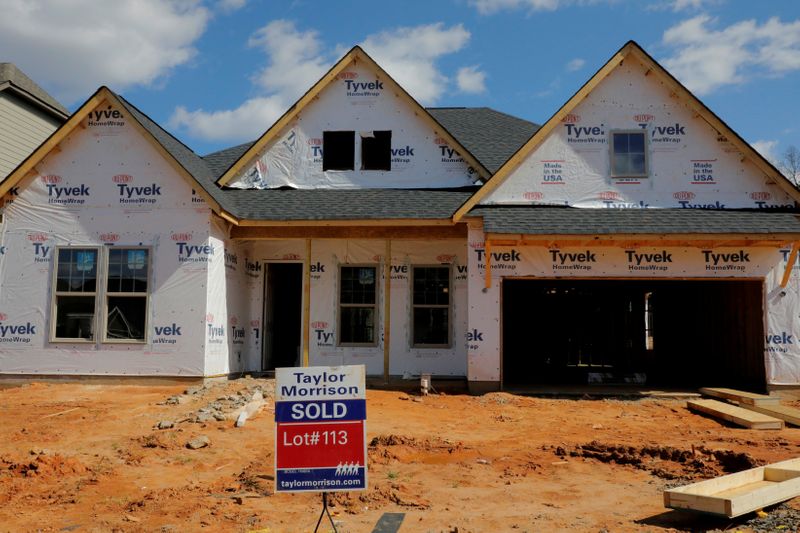By Lucia Mutikani
WASHINGTON (Reuters) - Contracts to buy U.S. previously owned homes fell for a second straight month in October as an acute shortage of properties pushed up prices, though the housing market remains supported by record low mortgage rates.
Other data on Monday showed activity at factories in the Midwest and Texas slowing this month, likely as a nationwide resurgence in new COVID-19 infections curbed new orders and disrupted production. The reports support expectations of a sharp slowdown in economic growth in the fourth quarter because of the raging coronavirus pandemic and depleted fiscal stimulus.
"Storm clouds are gathering," said George Ratiu, senior economist at realtor.com. "This winter could pose an unusual challenge for many people across the country, unless Congress takes significant actions."
The National Association of Realtors said its Pending Home Sales Index, based on contracts signed last month, decreased 1.1% to 128.9. Economists polled by Reuters had forecast pending home contracts, which become sales after a month or two, would rebound 1.0% in October.
Compared to a year ago, pending homes sales jumped 20.2% in October. The monthly decline in contracts suggests a slowdown in sales of existing home sales after they accelerated in October to their highest level since November 2005.
The housing market is being driven by record low mortgage rates. The COVID-19 pandemic, which has seen at least 21% of the labor force working from home, has led to a migration from city centers to suburbs and other low-density areas as Americans seek out more spacious accommodation for home offices and schools.
The coronavirus recession, which started in February, has disproportionately affected lower-wage earners. At least 20 million people are on unemployment benefits. The 30-year fixed mortgage rate is around an average 2.72%, according to data from mortgage finance agency Freddie Mac (OTC:FMCC).
U.S. stocks were trading lower on Monday. The dollar was steady against a basket of currencies. U.S. Treasury prices were mixed.
The United States is in the grip of a fresh wave of COVID-19 infections, with more than 4 million new cases and over 35,000 coronavirus-related deaths reported so far in November, according to a Reuters tally.
The resurgence is happening at a time when more than $3 trillion in government coronavirus relief has lapsed. The fiscal stimulus helped millions of unemployed Americans cover daily expenses and companies keep workers on payrolls, leading to record economic growth in the third quarter.
RISING LAYOFFS
Applications for unemployment benefits have increased for two straight weeks and about 13.6 million Americans will lose government-funded jobless benefits a day after Christmas. Another package is expected only after President-elect Joe Biden is sworn in on Jan. 20. President Donald Trump is consumed with contesting his electoral loss to Biden.
A second report on Monday showed the Chicago Business Barometer dropped to a reading of 58.2 in November from 61.1 in October. A reading above 50 in the index produced with MNI indicates expansion in factory activity in the Chicago area. The survey's new orders measure dropped for the first time since May, when the recovery from the pandemic started.
The moderation in factory activity was corroborated by another survey from the Dallas Federal Reserve showing its production index, a key measure of state manufacturing conditions in Texas, tumbled to a reading of 7.2 this month from 25.5 in October. Factories in the region reported a significant slowdown in new orders, and were less upbeat about the outlook.
The surveys, together with reports earlier this month showing a cooling in activity in factories in New York and the mid-Atlantic region, suggest national manufacturing moderated in November after accelerating in October.
The Institute for Supply Management is scheduled to publish its November survey on Tuesday. According to a Reuters survey of economists, the ISM national manufacturing index likely fell to a reading of 58.0 from 59.3 in October.
"The manufacturing sector is continuing to recover but remains below pre-pandemic levels," said Rubeela Farooqi, chief U.S. economist at High Frequency Economics in White Plains, New York. "The threat now comes from virus outbreaks that could interrupt activity, disrupt supply chains and weigh on demand."
Robust demand for housing has outstripped supply, boosting home prices out of the reach of many first-time buyers, despite builders ramping up construction. The government reported this month that single-family homebuilding, the largest share of the housing market, raced to the highest level since April 2007.
Though homebuilder confidence is at historic highs, builders have complained about shortages of land and materials.
In October, pending home sales edged up 0.1% in the South. They were unchanged in the West. Contracts dropped 5.9% in the Northeast and fell 0.7% in the Midwest.
"We expect a resurging pandemic, faltering recovery, and depleted inventories to weigh on home sales, particularly if no additional fiscal stimulus is forthcoming," said Nancy Vanden Houten, lead economist at Oxford Economics in New York.
